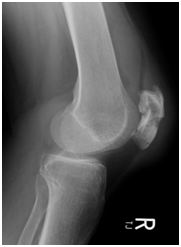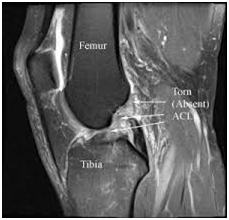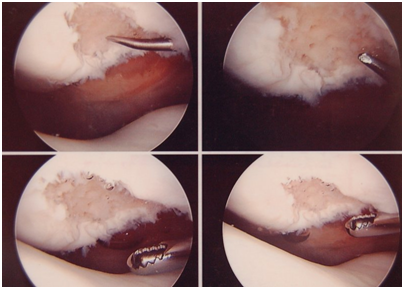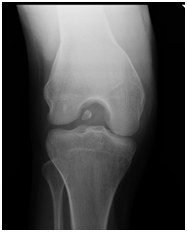Knee
KNEE ARTHRITIS
Arthritis can happen in any joint. Most commonly, arthritis is found in the weight bearing joints of the body; such as the knee. Arthritis is the wear and tear of the joint cartilage that leads to decrease in the joint space and symptoms such as pain and stiffness. Arthritis develops gradually over time and symptoms often present as the arthritis progresses. Diagnosis is confirmed with X-ray.
Along with pain and stiffness, patients may also experience night-time discomfort, loss of motion, and inability to walk long distances due to pain and limitation. Unfortunately there is no cure for arthritis. Once cartilage is damaged it cannot be replaced.
Several conservative treatment options exist to manage arthritic related symptoms. Anti-inflammatory pills or periodic cortisone injections inside the joint are helpful to reduce inflammation and pain. Physical therapy is also helpful to regain motion and strength.
Surgical treatment for knee arthritis is a knee replacement which removes the arthritic joint components and exchanges them for an artificial joint. After the surgery is complete, physical therapy will be initiated to regain motion and strength.
Click here to read more about this surgery and the recovery process.
MENISCUS TEAR
 There are two meniscus in your knee; a medial and a lateral. The meniscus are washer-like structures that sit between the two bones of the knee joint and provide cushion. Meniscus tears are a very common injury and often occur after some sort of twisting trauma to the knee.
There are two meniscus in your knee; a medial and a lateral. The meniscus are washer-like structures that sit between the two bones of the knee joint and provide cushion. Meniscus tears are a very common injury and often occur after some sort of twisting trauma to the knee.
Symptoms include swelling, popping, catching, clicking, pain and sometimes restricted range of motion. It is often painful to fully bend the knee and any twisting or pivoting on the knee elicits pain. Diagnosis is confirmed with an MRI.
Unfortunately the meniscus do not have a good blood supply and therefore most meniscus tears do not heal by themselves. Initial conservative treatment for tears involves reducing inflammation, pain and swelling, and regaining range of motion. Most meniscus tears, however, do require surgery. Surgery for this injury is done arthroscopically and involves removing the torn portion of the meniscus. Occasionally, a meniscus repair can be done. This option is reserved for tears in the meniscus close to the bone, or root, attachment. Type of tear and surgical recommendations depend on MRI results.
Click here to read more about this surgery and the recovery process.
ACL TEAR
The anterior cruciate ligament (ACL) is a large ligament in the back of the knee responsible for providing the joint with stability. ACL tears typically result from a high-energy impact such as changing direction rapidly, stopping suddenly, landing from a jump incorrectly, or from direct contact or collision. Often times a loud “pop” is heard.
Pain and swelling typically present within 24 hours of injury and are accompanied by instability. Once acute swelling and pain resolve, most patients feel well with regards to the knee. Unfortunately, when ACL tears are present, the knee continues to be unstable and patients are unable to return to their previous activities. Diagnosis is made during physical exam as well as with an MRI.
ACL tears do not heal by themselves and depending on patient age and activity level, surgery is usually needed. Surgery is done arthroscopically and reconstruction of the ligament is performed using either a donor graft or the patient’s own hamstring tendon. Should other internal derangement be present, such as meniscus tears, those will also be addressed at the time of surgery.
Click here to read more about this surgery and the recovery process.
PATELLOFEMORAL PAIN SYNDROME
Patellofemoral pain is a general term used to describe kneecap (patella) pain. This is often referred to as “jumper’s knee” or “runner’s knee” because it commonly occurs in athletes, and is slightly more common in young adults and women. Most common symptom is pain in the front of the knee making it difficult to climb stairs, bent, squat and kneel.
Patellofemoral pain can develop from continuous trauma, from a sudden change in physical activity such as frequency, duration, or intensity, or from improper training technique; usually poor stretching habits. This issue can also develop as a result of anatomical malalignment of the patella. This means the patella does not sit center in the femoral groove with which it slides and therefore does not track smoothly through range of motion.
Several factors contribute to poor patellar tracking although the most common is muscle imbalance, tightness, or weakness; the quadriceps muscles in particular. When the knee bends and straightens, the quadriceps muscles help to keep the patella within the femoral groove. Weak or imbalanced quadriceps can cause poor tracking of the patella.
This can be a frustrating and difficult problem and often takes some time to improve. Mainstay of treatment is reducing inflammation and working on stretching the quadriceps. Physical therapy and a dedicated home exercise program are encouraged and life-long maintenance is usually needed to keep symptoms from recurring.
For severe anatomical malalignment and progressive symptoms not relieved with conservative care, surgical options are available although not commonly needed.
MCL TEAR/SPRAIN
The medial collateral ligament (MCL) is one of two supporting collateral ligaments of the knee joint. These ligaments provide side to side stability for the knee. The MCL is injured much more commonly than the lateral collateral ligament (LCL).
The MCL usually injured through some sort of direct trauma to the knee pushing force against the ligament causing a sprain or a tear. Symptoms include pain over the inside portion of the knee, swelling to this area, and often instability. Diagnosis is confirmed through physical exam and often and MRI.
Treatment is conservative as this ligament heals well on its own. A supportive knee brace is recommended for the first four weeks following the injury to give the knee stability and allow the ligament to heal. Physical therapy is also recommended to regain strength, range of motion, and reduce pain.
PATELLAR INJURIES
Two common, and traumatic, injuries to the patella  include dislocation and fracture. Patellar fractures typically occur after a direct fall onto the knee. Fracture configuration can vary. Fractures can be stable, horizontal or vertical, or severely comminuted in multiple pieces. Treatment depends on the type of fracture. Unstable fractures, or markedly displaced fractures, will require surgery to reduce the fracture and stabilize it with hardware. Stable, non-displaced fractures can generally be treated conservatively with brace immobilization followed by gentle range of motion.
include dislocation and fracture. Patellar fractures typically occur after a direct fall onto the knee. Fracture configuration can vary. Fractures can be stable, horizontal or vertical, or severely comminuted in multiple pieces. Treatment depends on the type of fracture. Unstable fractures, or markedly displaced fractures, will require surgery to reduce the fracture and stabilize it with hardware. Stable, non-displaced fractures can generally be treated conservatively with brace immobilization followed by gentle range of motion.
Symptoms of patella fracture include swelling, bruising, and inability to bend or straighten the knee. Diagnosis is confirmed via X-ray.
Patellar dislocations also most commonly occur after a trauma, typically one of high-energy. During a dislocation, the patella slides out of the femoral grove and moves laterally to the outside portion of the knee. A visible deformity is noted at time of injury and manual reduction is needed, usually done in the emergency room or urgent care setting. Pain and swelling follow. Treatment, once the patella is reduced, involves brace immobilization followed by physical therapy.
A small ligament on the inside portion of the knee called the medial patellofemoral ligament (MPFL) is injured during a dislocation. This ligament heals by itself but often heals in an elongated position. This puts patients at risk for recurrent patellar dislocations. Should laxity in the MPFL become a problem, and dislocations become recurrent, surgical tightening or reconstruction of the MPFL can be done to re-stabilize the patella to prevent further dislocations.
KNEE CARTILAGE DAMAGE/LOOSE FRAGMENTS
Covering our knee joint is cartilage. Damage to this cartilage can happen in a number of ways although the most common is arthritis. Arthritis is the breakdown and thinning of cartilage which can lead to large areas of cartilage defect inside the knee. Localized areas of cartilage damage in an otherwise non-arthritic knee usually are the result of some sort of previous trauma causing injury to the cartilage in that area.
Diffuse cartilage damage, like that of arthritis, causes generalized stiffness, soreness and pain. Occasionally, cartilage damage can cause mechanical symptoms inside the knee such as popping and catching. This is usually from large cartilage flaps or loose fragments inside the knee that catch during range of motion. X-ray and MRI are used to confirm this.
While no great surgical treatment is available for arthritis other than a knee replacement, arthroscopy can be done for patients with mechanically symptomatic cartilage damage or loose fragments. The goal behind this minimally invasive procedure is to smooth out the cartilage defects and remove all detached fragments. Cartilage cannot be replaced and arthritis symptoms are still likely to be present even after the surgery. However, popping, catching and clicking associated with the loose fragments and/or cartilage flaps will improve.
Click here to read more about this surgery and the recovery process.



